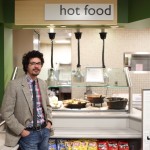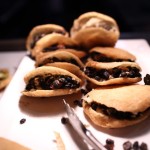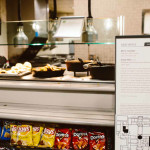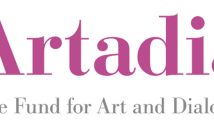By Stephanie Cardon
June 17, 2013
This conversation with John C. Gonzalez followed his participation in Odd Spaces, last month's day-long performance art event at the Museum of Fine Arts Boston, curated by Liz Munsell. With Family Meal Gonzalez initiated a collaboration with two of the Museum's cooks, Hamilton Luna Alvarez and Jodeson Francisco, each of whom prepared a dish which held cultural and personal significance to them to add to the day's menu. The cafeteria served arepas for lunch, a Venezuelan classic, while the dining room offered a three course prix fixe inspired by Brazilian cuisine. Of the four performances, Family Meal was the most discreet and the least directly concerned with the museum as a repository for art. But in terms of the spaces it engaged, it most acutely revealed the infrastructure of the institution and the people a museum depends on to function as a self-contained organism: those who provide the food that fuels it.
Stephanie Cardon You were born in Providence, but what cultural heritage do you claim and what place does it hold to you as an individual and in your work as an artist? This seems perhaps particularly crucial in the context of Family Meal.
John C. Gonzalez I was born in Providence, where I currently live with my wife and our son. My father is Hispanic, born in Puerto Rico and my mother is of Irish ancestry born in the US. Growing up, my father never emphasized Latino customs in our house. English was the only language spoken and is still the only language I speak fluently. Growing up, my inability to converse in Spanish with other Spanish-speaking kids limited my exposure to Latino communities and therefore I never really developed a Latino identity despite my traditionally Hispanic surname. I think of myself as American. Although I will always be fascinated by both Puerto Rican and Irish cultures, my own disconnection from my parents’ ancestral lineage (on both sides) has allowed me to define my own idea of cultural heritage as the sum of the various customs and communities that I have engaged with throughout my experiences. This way of defining one’s cultural identity is appropriate within the hybridized society of contemporary America and is a way of thinking about concepts of lineage and heritage that my wife and I have chosen to pass along to our son.
SC Tell me about the title Family Meal. Whose families were you thinking of? The visitors', the cooks', your own, the Museum as "family?"
JG In the restaurant industry food that is prepared by the kitchen for the purposes of feeding staff and not for customer consumption is referred to as a "Shift Meal" or a "Family Meal." Because these impromptu meals are for the kitchen staff only, they usually consist of an amalgamation of whatever is at hand and influenced by the cultural and social tastes of those that prepare and consume this meal. "Family Meal" then refers to the use of this term to contextualize the staff as a unified group or a family within the workplace.
SC While some of your pieces are durational in nature, you don't seem that hung up on performing feats of strength and stamina. Your approach is very inclusive. You seem to want, primarily, to engage others directly in participatory acts that place their individuality and identity on a par with your own. During your residency at sübSamsøn you began an ongoing collaboration with other artists on a series of Small Conversations. The artists you reached out to were all strangers to you, as were the cooks at the MFA. What do you gain from relinquishing a certain amount of control through collaboration, and being open to surprise? When do you choose to assert yourself and when do you pull back?
JG I think of duration as simply articulating a finite amount of time in which these projects are live. Dialogue is at the core of the work and many of these projects use relations as a catalyst to reframe or repurpose objects. These dialogical processes develop aesthetic choices, such as how an object should be constructed or for whom it should be made for, and allow for the resulting work to become a relevant form of documentation of these specific relations. In the case of Family Meal, the arepas are a result of my discussions with Hamilton, numerous visits to the kitchen, and the navigation of the institutional bureaucracy, etc. I think of the arepa, and as in much of my work, the object produced by these relations, as documentation. Moreover, within the context of this project, the act of both making the arepas as well as consuming them is performative.
In terms of Small Conversations, each of the projects are separate engagements that together form a series. There is a power dynamic in every collaborative relationship. This series aims to alter this dynamic by proposing a non-hierarchical approach where we both forfeit some of our authorship for the purposes of learning how to work in a new way. Letting the history, experiences, and interpretation of each participant have precedence will serve to define a collective aesthetic. When the Conversation is over, the elements of these new socially specific aesthetic processes then inform the work that we continue individually.
SC Beyond the idea of working with strangers, you also seem drawn to highlighting the overlooked or the too easily disregarded (I'm thinking of Trading Post at BU Art Gallery as much as Family Meal.) This applies as much to the invisible labor within an institution to sharing a temporary spotlight with other artists. In a way though, this approach ends up making you the artist-instigator less visible—almost like you are deliberately upsetting the power differential, using your access to give others access.
JG Because what is produced is inevitably "my work," there is no way for me to escape, in an absolute sense, the fact that I am the meta-author. But if my work is to be explicit about its interdependency within the social environment in which it occurs, then it must question the value of all actors involved. The "disregarded," to use your term, implies something that is exhausted, or ostensibly of little or no value. The scenarios I work to create in which the "disregarded" becomes the subject involve mechanisms that facilitate experiences that hide these mechanisms, sometimes deliberately sometimes not. Often, the factors that lead to why these mechanisms become concealed can be controversial and relational. The act of creating work in order to make these systems more self-reflective serves to unpack questions regarding viewer/participant relationships to these ideas and experiences.
SC While both meals took place within the walls of the MFA, they happened in two very different contexts. The arepas were served during lunchtime, in the cafeteria, and presented a far more affordable option than the three course dinner at Bravo restaurant, served that evening. Why pick two rather than one location, and what did you and the cook consider for each event? Talk me through the conversation you had with each of the two cooks, and how the dishes that followed were developed.
JG Family Meal took place in two separate kitchens at the MFA. I wanted engage both kitchens because each had a different workplace dynamic and viewer experience. In both instances, I wanted people to consider what they were eating, and the individuals who created and produced what they were eating. The initial conversations I had with the cooks involved an explanation of how what they were doing was an artwork within the context of this show. I then asked them to develop a meal that would be socially and culturally relevant to the kitchen staff.
SC Interestingly, the visual component of this work was next to invisible. I dined at Bravo, and split the $40 the Odd Spaces menu with a colleague, 'cause it was a little steep. Mostly because of the price, we ended up talking about privilege and access. We also talked about the discretion with which it was woven into the menu—it really was presented more like a daily special than a performance. I guess I'd hoped for something a little more visible, and less westernized in its presentation. Was presentation and the visual aspect of the meals something you developed much with the cooks? Was the restaurant staff prompted in how to talk about the piece to guests? What other aspects of the work did you have to consider given this unusual context?
JG I find it interesting that you expected the menu presentation for the Bravo Family Meal to be something different or elevated from what would normally appear on their menu. Because the development of a social specific aesthetic is a core component of my work, what was important here was that everything would function as a normal business day, other than the fact that the cooks Hamilton and Jodeson would be authoring decisions that would constitute their labor for these specific projects. Not only did my direction to let all signage and display decisions remain standard help reaffirm Family Meal as an artwork, because it would be the only alteration to the daily routine, it was imperative that nothing was sensationalized in order to legitimized their contributions as successful amendments to the restaurant and its primary goal as a business.
- John C. Gonzalez, Family Meal, 2013 Photo courtesy of Shane Godfrey Photography
- John C. Gonzalez, Family Meal, 2013 Photo courtesy of Shane Godfrey Photography
- John C. Gonzalez, Family Meal, 2013 Photo courtesy of Shane Godfrey Photography
- John C. Gonzalez, Family Meal, 2013 Photo courtesy of Shane Godfrey Photography
- John C. Gonzalez, Family Meal, 2013 Photo courtesy of Shane Godfrey Photography










